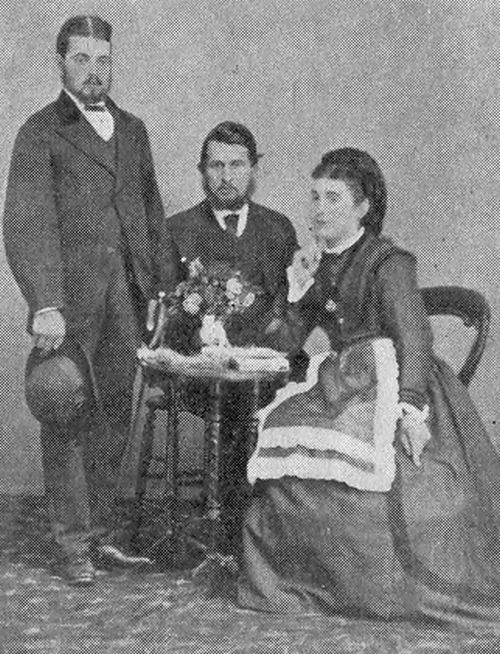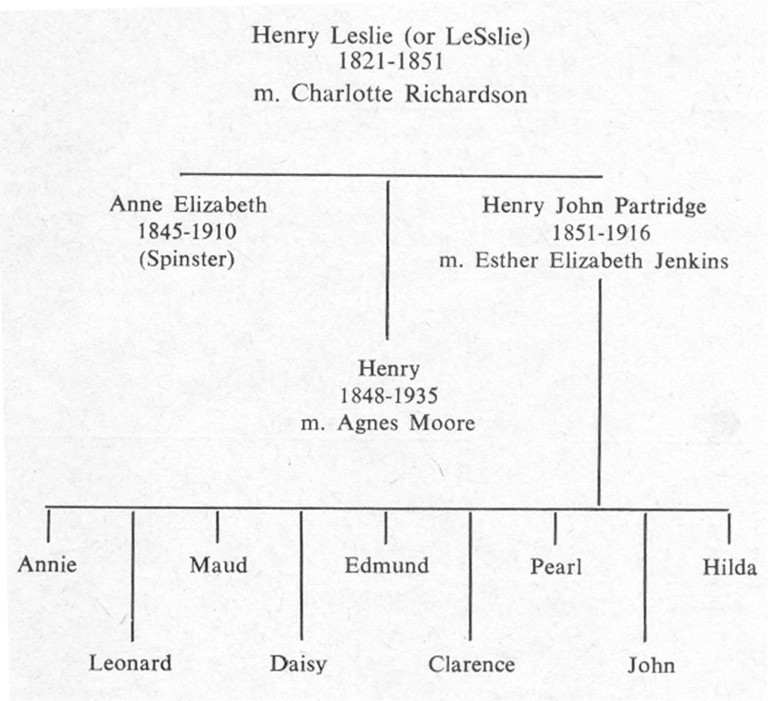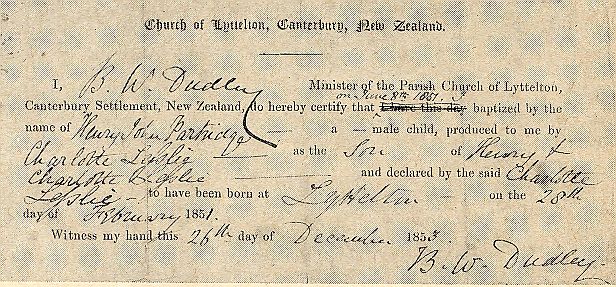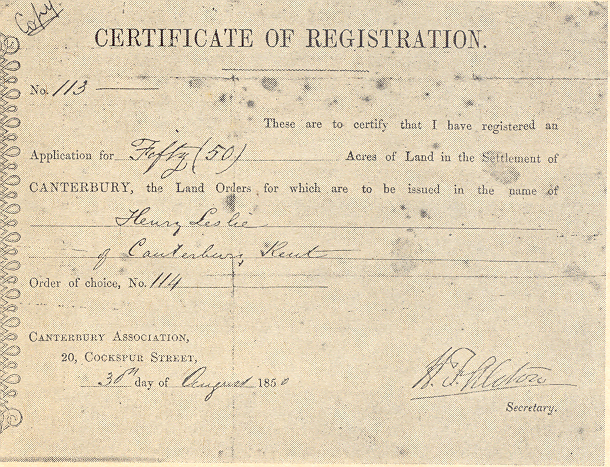









|
Leslie Family
 Partridge, Henry and Ann
Leslie
 Even though Captain Thornhill had specific
instructions to make to New Zealand with no stoppages, if at all possible.
Whooping Cough became prevalent, with several cases of fever also and the
medical supplies needed replenishing; so, on 29th November, the course of
the CASTLE EDEN was altered, so that, on December 12th, the anchor was
dropped off, Capetown.
While the Captain requisitioned some new crew; and
provisions were replenished, the passengers had some time on shore. Mr
Leslie, ignoring his wife's warnings, went ashore without warm clothing,
and in consequence, caught a bad chill. In the South African Colony, Land
was.being sold for a bottle of rum per acre, and Mr Leslie worried that by
purchasing fifty acres in Clnterbury, he had made a bad bargain. There
were also rumours that the new settlement at Christchurch was just
swamp.
The ship put to sea again, on the last leg of the
journey, on 21st December, with most passengers having benefited immensely
from the rest. The run to Stewart Island was tolerably favourable. However
strong contrary winds up the East Coast slowed the ship, and she did not
sight Banks Peninsula until Friday, 7th February. However, it was the fate
of Mr Leslie not to set foot on the laud which was to become the home of
his wife and children. The chill acquired by Mr Leslie at Olpetown,
combined with worry, and the lack of medical facilities on board
culminated in his death as the CASTLE EDEN dropped anchor in Lyttelton
Harbour on February 14th, 1851. The ship's records state simply-"One of
the passengers, Mr Leslie, who had been sinking for some time, died the
morning after the arrival of the vessel." Three births, three marriages
and three deaths occurred during the voyage,and but for the stop at
Capetown, the CASTLE EDEN would have been considered as expeditious as the
earlier four ships of the Association.
And, so it was, that Mrs Leslie, the widow, and
her two young children, came ashore on one boat, followed by another
containing the coffin of her late husband. Mr Leslie was buried in the
Anglican Cemetery at Lyttelton (Book 109D, page 774). However, the exact
position has not been ascertained, as the church records only go back to
1860. As land had been purchased in England before departure, Mrs Leslie
was entitled to the privilege of living in the Immigration Barracks in
Lyttelton, for twelve weeks. It was in these birracks that Henry John
Partridge was born on 28th February, 1851. He was baptised on June 8th,
1851 (Book 109D, page 775) by the Rev. B. W Dudley.
 Despite the good preparations made in England by
Henry Leslie, the young family had many a hard time to face in those first
years. When Mrs Leslie left the Barracks, the family shifted to a sod
whare which she had purchased. This investment turned out to be a
dead loss, as the whare had been built on public land, and the
family were obliged to move. A section was then bought at Salt's Gully
(Lyttelton area) where they lived for many years. During this time, Mrs
Leslie took in sewing to assist the family finances
With the children growing up, Mrs Leslie decided
that it was time to see what the estate at Riccarton was like, and to take
final possession of it, by setting foot on it. She borrowed a horse and a
saddle from Mrs Robert Godley, and hired a man to lead it over the many
bogs, creeks, and streams on the way. Mrs Leslie, taking Henry'John
Partridge with her, came over the Bridle Path and then down the Heathcote
Valley, which in those days was nearly all covered in water, being such
low land
 Having taken formal possession of her land,
accommodation for the night had to be sought at Riccarton. This was kindly
offered by a Mr Gregg, who gave up his bedroom and slept in a shed
outside, so that Mrs Leslie and her small son could have .a good night's
rest.The Canterbury Block, as the earliest settlers saw it, consisted of
three distinct belts. Along the coast, was a strip of heavy wet land,
usually some ten miles wide, and covered largely with rank swamp grasses,
higijer than a man. Water cresses were there in plenty, and the luxuriant
growth afforded by this land, had an abundance of pukeko and bitterns,
whilst it was relatively common to see flocks of up to 60 Paradise ducks,
flying overhead: other ducks, such as teals and greys as well as
spoonbills, were also very common.
The swampy areas gradually gave way to dry stony
plain, covered with light scrub and tussock. Wild Irishman, a very spiny
plant, grew up to 3 ft 6in high, with needle sharp points, and yellow
flowers on a seed head, ;went up from its base each year. Beyond this
again, were the lower foothills of the great mountain chain on which
tussock and scrub prevailed, although the valleys were often fertile and
forested. Fauna abounded about early Christchurch, with introduced
pheasants being so abundant, that, when a twelve-acre paddock of Mr Dean's
(earliest settlers) was mowed fifteen pheasants and ten hares were killed,
through getting tangled up in the mowing machine. Parakeets, which used to
come down from the Oxford Bush, were a nuisance among the cherry trees and
other fruit trees, while bats and moreporks were also present in moderate
numbers.
The site of Christchurch and of the rural
allotments of the first land purchasers, was what became known as "dry
swamp", moderately wet land, with native flax, toi toi, cutty gra;;s, and
sometimes heavy fern, with boggy creeks running through it. Before
cultivation, this vegetation had to be stripped by hand with a mattock (a
form of grubber). When the ground was thus cleared and burnt off, it was
ploughed with a single-furrow plough. In Mrs Leslie's case, a horse and a
cow yoked together, pulled the plough, before the ground was harrowed with
a tine harrow, or sown by hand on the furrow. Often sheep were driven to
and fro across the furrows, after sowing the seed to act as harrows and
roller. When ready, crops were reaped with a scythe or a sickle, stacked,
and then threshed with a flail. '
In the 1860's and 1880's, the Plains beyond the
Riccarton Bush had no trees on them, and there was a mantle of snow at
least a third of the way down the ranges, even in the hottest summer. With
no trees to break the wind, the nor'westers blew across the plains with
terrific force, and in the 1860's there were many stories circulating such
as the following A man left his horse tied to a fence one windy day, but
when he returned, its saddle had been blown clean off, even though double
girthed. On another occasion, a farmer was ready to stook hay, when such a
blustery wind came up, it was too windy to work. He lay down and slept
with his head on a stook, and when he awoke, was shocked
to find that the only stook left in the paddock, was the one on
which he had his head. The likes of these stories
may not be exaggerated, as, on the farm at "Glendale", Ma Waro, which was
the eventual home of Clarence, newly cut sheaves of oats have been seen
moving end over end up rather steep hills, before finding a resting place
on more sheltered ground.
Fences in the early days, largely depended upon
where people lived; if near a forest, fences were of post and rail;
otherwise, sod wall, or ditch and bank fences were made. Fences were made
five feet high from the top to the bottom of trenches. Alongside the
trenches, which were five feet wide, was planted gorse, until a "Cabbage"
Wilson wrote a book abount gardening, in which he advocated planting gorse
and broom alternately. This proved to be poor advice, however, as the
stock ate and rubbed up against the broom, ultimately breaking through
Soon after having taken formal possession of the Riccarton land, the
decision was made, to move there permauently. The purchase of the fifty
acres, in England, had entitled the family to half an acre of land in the
"city to be", this being where (in 1919) the Jewish Rabbi's house
stood.
The trip from Lyttelton to Riccarton was made,
firstly over the Bridle Path, walking and carrying what possessions they
could. Then they were ferried over the Heathcote River where in 1928, the
Tramway tanks stood on the Christchurch side. Here they were met by
Don and Bishop's (grocers) carts, which took them to Gloucester Street.
The Leslie's heavier possessions came by sea, over the Sumner bar, and
then up the Heathcote River. A small two roomed house was rented, while
their own, of similar size, was being built on the Gloucester Street
section, by a Mr Dilloway, who later owned "The Plough Inn", Riccarton's
first hotel.
Some years after having arrived at Riccarton,
there was a search for the best bullock in the Christchurch district, for
a banquet for the visit of the Duke and Duchess of Edinburgh. Mrs Leslie's
beast was the best found, and she received twenty pounds (£20) for the
sale. The fifty acre block was farmed until Charlotte's death in 1870,
when the area was left to Henry. Being the fair minded man he was he
sub-divided the areas (Gloucester Street and Riccarton) into three equal
portions, in 1875, transferring the northern portion of the Riccarton
property to Partridge, the centre one to Ann Elizabeth, retaining the
southern portion himself. Partridge sold his portion in 1885.
Partridge's eldest daughter, Annie, spent her
childhood with her Aunt Annie and Uncle Henry at Riccarton Waimairi Road),
and finally inherited the greater portion of her aunt's property. Henry
(who had married Mrs Agnes Moore) lived on the property, until he (lied in
1935. Some of the property was sold-the remaining area was left to
Partridge's two eldest sons, Leonard and Edmund. It is now Canterbury
University property.
By the end of the 19th century, the two elder
children of Henry Leslie, who came out from England with their parents,
were still unmarried. Ann died a spinster. Henry married Mrs Agnes Moore,
late in life-a widow with two daughters. Henry John Partridge had a
flourishing family of four boys and five girls, and had bought a farm at
Aylesbury. While living there, Partridge uscd to work about Christchurch,
doing carpentering, bricklaying and similar jobs, walking to Ayles,bury at
weekends; arriving home at about 11 p.m., and walking back to Christchurch
on Sunday. For all this travelling, Mr Leslie earned the nickname of
"Night and Day" Leslie, from some of his friends.
The Aylesbury farm was sold in 1906, and a
property bought at West Melton, only fourteen miles from Christchurch, at
ten pounds (£10) per acre, 272 acres. This meant that Mr Leslie could do
more carpentry work nearer home, and the farm was leased to the elder
sons, Leonard and Edmund. They did a great deal of work to bring the farm
up to standard; gorse fences were trimmed from being yards wide, and the
standard of the farm much improved in over three years. When the lease
expired, a younger son, Clarence, who had been working at his Uncle Ernie
Jenkins' farm at Waddington, came home to work the team of horses and help
run the farm. By this time, Annie, Maud and Daisy had married. Edmund and
Clarence had worked on various neighbouring farms, and Clarence
had been in partnership with Len at
Halkett for 1hree years, before Len bought the farm at Harewood. The West Melton property was sold in 1912, for seventeen pounds (£17) per acre (a good profit). Len married, with children, farmed his twenty acres at Harewood, supplementifig his income by taking on a milk run. Selling out from there, he bought a farm at Cust, and founded a very successful Friesian herd. Later he sold out, and came back to live in the old family property on Waimairi Road. After selling the West Melton property, Mr
Leslie Snr. (H.J.P.) retired, with his family, to 344 River Road,
Christchurch. Clarence then worked on various farms, and a threshing mill
(before enlisting).
Edmund also did farming jobs for various people; (he and Clarence enlisted together). Jack went mustering at Fendlehurst and Molesworth; Pearl, after attending Commercial College, took a position in an office, and Hilda attended High School With the outbreak of World War I, there was a break in the family, when Edmund and Clarence enlisted in 1916. They met up with George Masterton in camp, (later to become their brother-in-law, marrying Pearl) and spent most of their soldiering days in France. Edmund and George were wounded (not seriously) and spent several months in hospital in England, convalescing. They thus moved home a little earlier than Clarence, who came through unscathed, and had also spent some weeks with the Occupation Army in Germany. The younger son, Jack, enlisted later, and got to camp. However, he contracted influenza in the epidemic of 1918 and almost died. He was so ill at one stage, that his mother in Christchurch was officially informed that she should go to Featherston to see him. All ended happily, however, with the family re-united in 1919. After "final leave", the brothers Edmund, Clarence and Jack, and George Masterton, went into partnership in a farming venture of 3,004 acres, a few miles from where the town of Tokoroa now stands.
Press, 22 April 1935: MR HENRY LESLIE: Mr Brian Leslie of Blenhein shared his book "The Leslies - a Portrait of a Pioneer family" after the Guilford Reunion in 1976 at Christchurch. It outlined the life of fellow steerage passenger immigrants on the Castle Eden - Henry Leslie, aged 29Y, occ; Cow Keeper who died on arrival at the Lyttelton Harbour; his wife, Charlotte Leslie aged 37Y and their 2 children, Ann 7Y and John Henry aged2. |